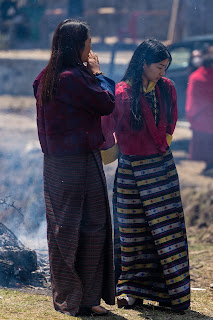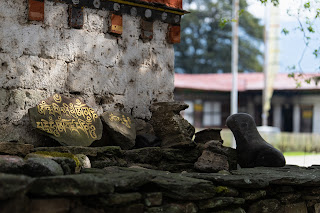Feeling better the next morning, I was far more interested in stopping for pictures than the day before. We stopped once we reach the bottom of the bumpy road, to admire the farmland and river. As I was returning to the vehicle, I saw a man sitting under a tree. I mimed taking a photo with a thumbs up and he indicated that it was ok to take his picture.
Down the road I noticed a Mickey Mouse on a building wall. It was a school.
Jeremy and I believe that it was shortly after that we reached a cliffside, stuck behind a slow tractor. Shockingly, there were guard rails on this turn. The tractor stopped to us pass. The van in front of us squeezed by, but scraped their vehicle in the process. We passed unscathed, though I found the experience hair raising. The van stopped to survey the damage.
Once in Jakar, we stopped at their Dzong.
 |
| A back path used by the fort. |
Next was Jamphel Lhakhang, a temple with metal decorations in the windows. Inside the temple sat the head monk, which blessed Rye. Jeremy, who stayed nearer to Rye, informed me that they deliberately didn't update this temple.
Kurjey Lhakhang was a temple complex with stupas on one side and a mountain on the other. As we got out of the car, I noticed people were hiking down the side of the mountain. I later understood that they were circling the temple, which required going up the mountain to circumnavigate it.
There was a man painting stones and selling them on a small table. Rye and Jeremy kept walking. I bought four.
Tamshing Lhakhan was a monastic school that did not have the funding to maintain the temple insides. As a result, the internal walls reminded my of cave drawings. Photos were not allowed and this was the most beautiful thing on the trip that we couldn't capture(in my opinion.) I loved it.
Konchogsum Lhakhang was the upper school that Tamshing's graduates would come to. The inside was grand, but I was growing tired of temples at this point. Rye took us on a very long tour, stopping to explain the details of every room. My feet hurt on the hard floors, and I wanted to move on. We skipped the last stop of the day.

Back on the main street of Jakar, I had us look in Dragon Handicraft. The door was locked, but soon a worker returned. They lost power but allowed me to shop anyway. Using my phone as a flashlight, I walked back to the third and final room, filled with beautiful mandalas and wheel of life style artwork. I fell in love with one of their largest sized mandalas. They wrapped it up while I was examining one of the wheel of life pieces. They struggled with their credit card machine. Eventually the power came back on and we were able to get it sorted. I learned that you needed paperwork granting permission to bring Buddhist art out of the country. Rye coordinated with the owner to get the paperwork sent to Paro, to be collected once we got there. I had it with me in the airport, but no one asked for it.
The next morning I was tempted to return, to buy the other piece. Jeremy reminded me that we had to budget our time for the long drive ahead. I still wish that I had bought it.
 |
| Jakar's main street. |
The next day began our two day journey back west, toward Paro, just beyond Thimpu. As we approached the Yotongla Chorten Pass, there was a large caravan stopped on the road. Dozens of monks were wandering around. Rye explained that twice a year, Buddhist relics are transported from one temple to another, so that other people could have a chance to enjoy them. We had caught them in the middle of one such transfer. People approached the backs of the trucks to be blessed by the relics. Others took selfies or took pictures in the front. The monks were the most joyful I had seen them.















We took a short break at the Willing Waterfall Cafe, where we sat by a waterfall for cake and coffee. Later, we stopped at the Norbu Yangphel Restaurant. While driving, I asked Rye about smoking in Bhutan. He explained that it was prohibited in public. Online searches confirmed that Bhutan was the first country to ban tobacco sales and smoking in public places. Before sitting down at the restaurant, I wandered the street briefly. As I returned to the restaurant, I caught a man smoking.
At lunch, Jeremy was served tea with leaves inside. He, of course, volunteered to have his picture taken.
We otook photos on the side of the road:
We took a short break to walk around the village of Rukubji. We climbed up to the temple, walked the length of town. A long hike over the mountains leads here, and we saw a group finishing it. The villagers were super friendly.
 |
| Just a sight I was fascinated with, from the main highway. |
We returned over the Pelela Pass, and took a left, toward Phobjikha Valley. We ascended along a steep cliff. We reached another pass, called Lawa La. I had us stop to look at baby yak goods.
Our last stop of the day was in Gangtey, with its one street leading to a monastery. Rye directed us toward the inner temple, but I stayed outside while they went in.
We walked down the street and enjoyed how the setting sun lit up the town. I ducked into a local art store and bought another piece. Our hotel was just a few minutes away, in Nubding. The hotel and food were incredible.
 |
| On the short road to our hotel, I saw this woman in the distance. |
Jeremy and I went for a walk at sunrise, before breakfast. It was very hazy..
We drove west, toward Paro. This is some of what we saw:
Once in Paro, we were brought to lunch. Unfortunately, there was an large group of extremely large Indians. They read jokes out loud, from the internet to their entire group. It was as if we did not exist to them.
At the National Museum of Bhutan, I waited outside. We were supposed to go to the Paro Dzong, but I was more interested in searching for a gho in town. Jeremy agreed with skipping the dzong.
I hadn't found any shops that were obviously selling them, but Rye promised that there would be many in Paro. We were driven to a line of very touristy shops in Paro, that were not to my taste. I had bookmarked a store ahead of time, the Chencho Handicraft and Weaving center. Two women were using a loom up front, and the store sold exactly what I was looking for. Rye needed to go across the street, so he asked the store owner, in Bhutanese, to keep an eye on us. I asked her where we could find gho. She helped me assemble a gho, having me choose the cloak, belt, undershirt, stocking, and formal sash. She also helped dress me.




About five minutes before dinner, the power went out. It was to be another dinner by candlelight. The hotel had some problems. When I arrived, electric outlets in my room didn't work. Two mornings in a row, group tours loudly boarded buses at 5 AM. There was little consideration given for those still asleep. One night had extremely loud music, that was able to reach us from the lobby, despite the two halls and steps that separated us. This was my least favorite hotel of the trip.






























































































No comments:
Post a Comment